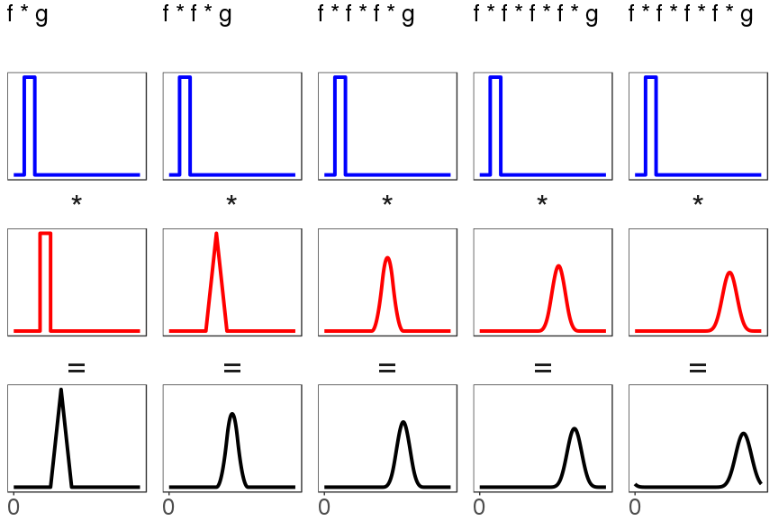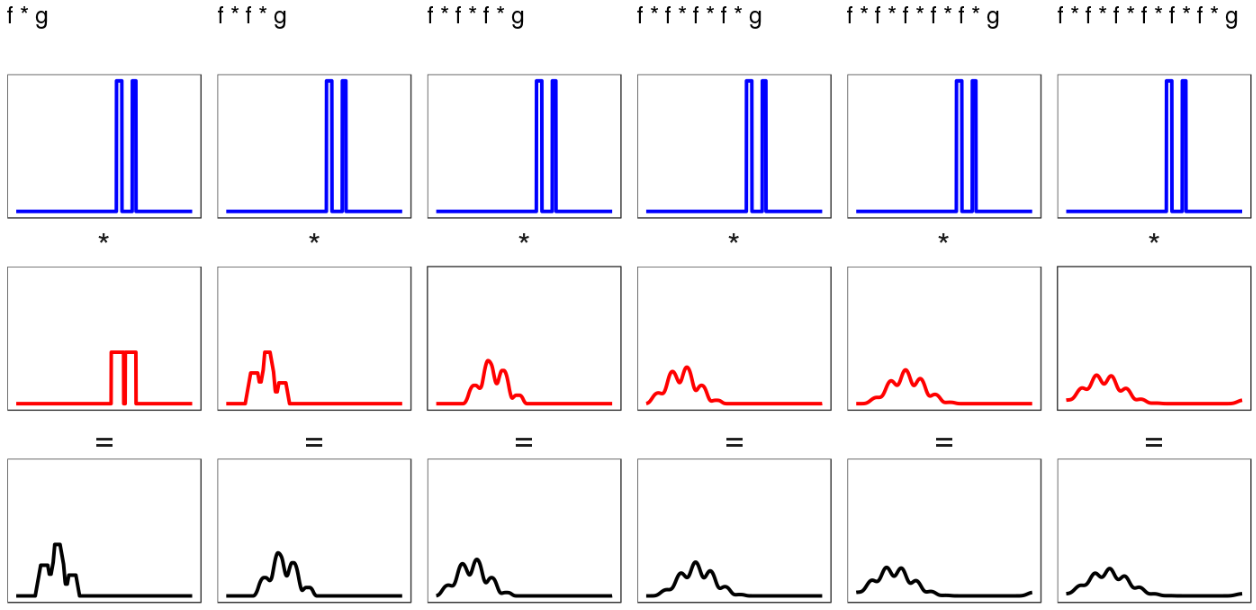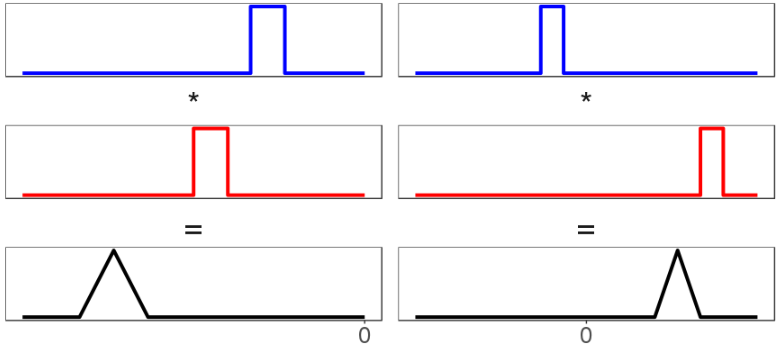Convolution as smoothing
post by Maxwell Peterson (maxwell-peterson) · 2020-11-25T06:00:07.611Z · LW · GW · 5 commentsContents
Understanding convolution as smoothing tells us about the central limit theorem None 5 comments
Convolutions smooth out hard sharp things into nice smooth things. (See previous post [LW · GW] for why convolutions are important). Here are some convolutions between various distributions:

(For all five examples, all the action in the functions and is in positive regions - i.e. > 0 only when x > 0, and too - though this isn't necessary.)
Things to notice:
- Everything is getting smoothed out! Even the bimodal case, in the column all the way to the right, has a convolution that looks like it's closer to something smooth than its two underlying distributions are. You might say the spike that uniform uniform gives doesn't seem more smooth, exactly, than the uniform distributions that led to it. But notice the second column, which convolves a third uniform distribution with the result of the convolution from the first column. That second convolution leads to something more intuitively smooth (or if not smooth, at least more hill-shaped). We can repeat this procedure, feeding the output of the first convolution to the next, and each time we get a black result distribution that is a little bit shorter and a little bit wider. Thus we get a smooth thing by repeatedly convolving two input sharp things (f and g):

- Even the more difficult bimodal distributions smooth out under repeated convolution, although it takes longer:

- (for positive and ) is always to the right of and both. Because all these example and are positive, their means are positive. And it's a theorem that the mean is always equal to the sum of the underlying means . So the location of the distributions is always increasing. Of course, for and with negative first moments, the location of would go leftward; and if had negative mean but had positive mean, the mean of could go anywhere. I am actually just describing how addition works, but the idea that you could locate a distribution just by summing the locations of and was so shocking to me initially that I feel like I should emphasize it.

Understanding convolution as smoothing tells us about the central limit theorem
From Glen_b on stackoverflow:
Convolution acts as a kind of "smearing" operator that people who use kernel density estimation across a variety of kernels will be familiar with; once you standardize the result... there's clear a progression toward increasingly symmetric hill shapes as you repeatedly smooth (and it doesn't much matter* if you change the kernel each time).
(a kernel is like a distribution; italics are mine.)
Up till now I've just called it "smoothing", but convolution on most (all?) probability distributions is better described as a smoothing-symmetricking-hillshaping operation. The graphics above are examples. And remember: The central limit theorem is a statement about convolutions on probability distributions [LW · GW]! So here's a restatement of the basic central limit theorem:
Convolution on probability distributions is a smoothing-symmetricking-hillshaping operation, and under a variety of conditions, applying it repeatedly results in a symmetric hill that looks Gaussian.
Or you could look at it the other way around: The central limit theorem describes what comes out on the other side of repeated convolutions. If someone asked you what the behavior of was, you could answer with the contents of the central limit theorem.
Because your answer was the central limit theorem, it would contain information about: how varying the shapes of the component distributions affected the shape of ; how many distributions you needed to get close to some target distribution ; and what the needed to look like in order for to look Gaussian. It would also contain the same kind of information for the moments of , like the mean. And the variance. It would describe how to use the skew (which corresponds to the third moment) to evaluate how many distributions you needed for to look Gaussian (the Berry-Esseen theorem).
These information, together with various additional conditions and bounds, constitute a network of facts about what kinds of probability distributions cause to look Gaussian, and how Gaussian it will look. We call this network of facts "the central limit theorem", or sometimes - to emphasize the different varieties introduced by relaxing or strengthing some of the conditions - the central limit theorems.
*: While this kind of thing is true for many distributions, see Gurkenglas in the comments for why we shouldn't take "it doesn't much matter if you change the kernel each time" too literally.
5 comments
Comments sorted by top scores.
comment by Gurkenglas · 2020-11-26T06:29:55.279Z · LW(p) · GW(p)
and it doesn't much matter if you change the kernel each time
That's counterintuitive. Surely for every there's an that'll get you anywhere? If , .
Replies from: maxwell-peterson↑ comment by Maxwell Peterson (maxwell-peterson) · 2020-11-26T07:16:56.170Z · LW(p) · GW(p)
Yes, that sounds right - such an exists. And expressing it in fourier series makes it clear. So the “not much” in “doesn’t much matter” is doing a lot of work.
I took his meaning as something like "reasonably small changes to the distributions in don’t change the qualitative properties of ". I liked that he pointed it out, because a common version of the CLT stipulates that the random variables must be identically distributed, and I really want readers here to know: No! That isn’t necessary! The distributions can be different (as long as they’re not too different)!
But it sounds like you’re taking it more literally. Hm. Maybe I should edit that part a bit.
Replies from: Gurkenglas↑ comment by Gurkenglas · 2020-11-26T10:31:12.783Z · LW(p) · GW(p)
The fourier transform as a map between function spaces is continuous, one-to-one and maps gaussians to gaussians, so we can translate "convoluting nice distribution sequences tends towards gaussians" to "multiplying nice function sequences tends towards gaussians". The pointwise logarithm as a map between function spaces is continuous, one-to-one and maps gaussians to parabolas, so we can translate further to "nice function series tend towards parabolae", which sounds more almost always false than usually true.
In the second space, functions are continuous and vanish at infinity.
This doesn't work if the fourier transform of some function is somewhere negative, but then multiplying the function sequence has zeroes.
In the third space, functions are continuous and diverge down at infinity.
↑ comment by Maxwell Peterson (maxwell-peterson) · 2020-11-26T19:26:07.868Z · LW(p) · GW(p)
Hm. What you're saying sounds reasonable, and is an interesting way to look at it, but then I'm having trouble reconciling it with how widely the central limit theorem applies in practice. Is the difference just that the space of functions is much larger than the space of probability distributions people typically work with? For now I've added an asterisk telling readers to look down here for some caution on the kernel quote.
Replies from: donald-hobson↑ comment by Donald Hobson (donald-hobson) · 2020-11-28T14:48:47.874Z · LW(p) · GW(p)
Suppose you take a bunch of differentiable functions, all of which have a global maximum at 0, and add them pointwise.
Usually you will get a single peak at 0 towering above the rest. The only special case is if In the neighbourhood of 0, the function is approximately parabolic. (Its differentiable.) You take the exponent, this squashes everything but the highest peak down to nearly 0. (In relative terms). The highest peak turns into a sharp spiky Gaussian . You take the inverse Fourier transform and get a shallow Gaussian.
Even if you are unlucky enough to start with several equally high peaks in your 's then you still get something thats kind of a Gaussian. This is the case of a perfectly multimodal distribution, something 0 except on exact multiples of a number. The number of heads in a million coin flips forms a Gaussian out of dirac deltas at the integers.
But the condition of having a maximum at 0 in the Fourier transform is weaker than always being positive. If then